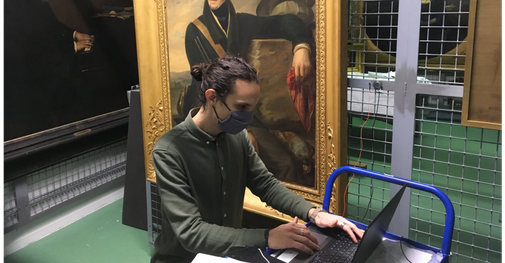Système de contrôle actif de vibrations pour la préservation des objets du patrimoine
Loïc Forma, doctorant de CY Cergy Paris Université a effectué sa thèse au sein des laboratoires SATIE, STMS (Ircam-Sorbonne Université-CNRS-Ministère de la Culture), du Musée de la musique et de l'INP (Institut national du patrimoine). Il a bénéficié d’un financement de la Fondation des sciences du patrimoine.

Il soutiendra sa thèse à l'INP, en français. Il sera aussi possible de le suivre en direct sur https://us06we
b.zoom.us/j/86598800048?pwd=xx3GSqBOBJ7EG0ycsawQTZVi3SiH3e.1
Jury :
- Hervé Lissek, Ecole Polytechnique Fédérale de Lausanne, Rapporteur
- Patrice Masson, Université de Sherbrooke, Rapporteur
- Ioan Doré Landau, GIPSA-lab Grenoble, Examinateur
- Marc Lethiecq, Université de Tours, Examinateur
- Nicolas Wilkie-Chancellier, CY Cergy Paris Université, directeur
- Henri Boutin, Sorbonne Université, co-encadrant
- Marguerite Jossic, Musée de la musique, co-encadrante
- Sandie Le Conte, Institut National du Patrimoine, co-encadrante
- Eléonore Kissel, Musée du Quai Branly, invitée
Résumé :
Dans un contexte patrimonial, les vibrations représentent une véritable menace quant à la préservation des objets. Pourtant, les dispositifs de protection des vibrations employés sont généralement très rudimentaires et les systèmes proposés dans la littérature scientifique ne sont pas appliqués, principalement par manque de considération pratique. Pour dépasser ces limites, les travaux présentés dans cette thèse s'articulent autour du développement d'un nouveau type de système de protection, basé sur le principe du contrôle actif de vibrations.
La conception du dispositif de contrôle commence par l'établissement d'un cahier des charges au double objectif. D'une part il définit les objectifs de contrôle des vibrations rencontrées en domaine patrimonial, d'autre part il formalise les considération pratiques des acteurs du patrimoine. Le cahier des charges permet alors d'identifier la stratégie de contrôle la plus adaptée au respect des spécifications formulées. En l'occurrence, le contrôleur est conçu comme un dispositif autonome et indépendant qui vient se greffer à la structure à protéger et utilisant un algorithme de contrôle adaptatif et de type feedforward.
Un dispositif de contrôle expérimental dont le contrôleur est actualisé par l'algorithme Filtered-x Least Mean Square (FxLMS) est conçu afin d'éprouver sa capacité à respecter le cahier des charges. Ce dispositif est testé dans un premier temps sur une structure à la dynamique relativement simple, puis sur un banc d'essai représentatif d'une situation couramment rencontrée en contexte patrimonial. Une fois le dispositif validé, un outil permettant de comparer quantitativement, objectivement et robustement les performances de différentes situations de contrôle est proposé. Cette méthodologie passe par l'extraction de descripteurs de performance, chacun d'entre eux devant représenter un aspect du contrôle qu'il est souhaitable de quantifier.
Si l'utilisation du FxLMS permet de valider le cahier des charges, une hypothèse forte de cet algorithme restreint son champ d'utilisation. Une solution à cette limite est l'utilisation d'algorithmes de contrôle plus récents et basés sur la paramétrisation de Youla-Kuçera. Une étude paramétrique définit les conditions à partir desquelles les performances du FxLMS ne sont plus acceptables, et l'utilisation du benchmark permet de quantifier les performances des nouveaux algorithmes proposés.